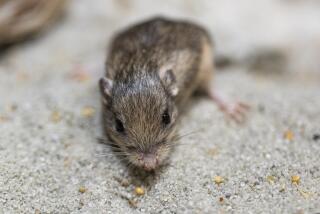Why the city mouse and the country mouse have different genes
- Share via
A white-footed city mouse scampering around the urban parks of New York City may look identical to his country cousins living in the rural forests just a few miles away, but genetically they are worlds apart.
In a paper published this week in Biology Letters, researchers report that just 400 years of city living -- a blink of an eye in evolutionary time -- has managed to affect the genetic makeup of the urban white-footed mouse.
“It was such a clear story,” said Stephen Harris, a lecturer in evolutionary biology and postdoctoral researcher at Columbia University who is the first author of the paper. “The genomes of the urban park mice show times of isolation about 400 years ago -- which is about the time the first Europeans arrived.”
White-footed mice, scientifically known as Peromyscus leucopus, have lived in the New York area for millions of years. They are a little bigger than the house mouse that nibbles your cardboard boxes and streaks across the floor when you turn on the light. Their eyes and ears are bigger too, and their noses are a little more pointed.
White-footed mice don’t like human homes. They are abundant across America and favor forests -- including the relatively small urban ones like Central Park in Manhattan and Fort Tilden in Queens. Harris explains that they prefer to stay where it is green and don’t often cross the urban matrix. They don’t even like to cross the street, which has led to isolated and genetically distinct populations in the various parks in New York City.
Even before this study began, the research team lead by senior author Jason Munshi-South, an urban ecologist at Fordham University in New York, knew that there were genetic differences between white-footed mice in cities and their cousins in the country. However, they could not be sure that those differences were due to urbanization.
To see whether city living was indeed responsible, the researchers looked at the several thousand DNA fragments from across the genomes of 191 individual mice sampled from 23 sites.
By comparing the DNA data to computer models, they found that there were two distinct landscape processes that had an effect on the evolutionary history of the rodents.
The first one occurred about 12,000 years ago at the end of the last ice age when sea level rise associated with receding ice glaciers separated Long Island from mainland New York.
The second took place much more recently, when green space in New York City came to be surrounded by dense urban development about 400 years ago.
“The exciting thing is that the times of the divergence that we inferred lined up with the arrival of Europeans in New York,” Harris said.
The group’s next step is to sequence specific genes of the mice and see whether any of them show evidence of positive selection. For example, it is possible that city mice have evolved different immune and metabolic systems than their country cousins to help them deal with the unique pressures of city living.
The behavior of the two groups of mice may have diverged as well, Harris said. White-footed mice in the city have fewer predators and less competition for food resources from deer that are found in rural areas. Also, the urban heat island effect means city mice generally enjoy a slightly warmer climate than those in rural areas.
These environmental differences could affect reproduction strategies and other behaviors.
Although the field of urban evolutionary genomics is still in its early years, Harris said, it is an important line of study.
“Given the increase rate of urbanization around the globe and other anthropogenically driven changes, it’s important to understand how organisms adapt,” he said.
Do you love science? I do! Follow me @DeborahNetburn and “like” Los Angeles Times Science & Health on Facebook.







